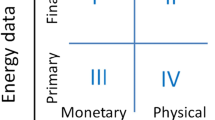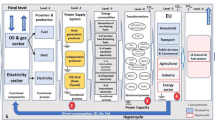Abstract
This analysis explores the possibility of merging into a ‘combined’ proposal two standard I-O methods identifying key sectors, the Classical Multiplier and Hypothetical Extraction. In the context of the latest revision of the European Union Energy Efficiency Plan, we use this proposal to single out key sectors that boost potential energy savings in the economic system—specifically, in the production and distribution of electricity. Using the main distinctions and complementarities of the two traditional I-O key-sector approaches, the combined formulation allows us to disaggregate the backward stimuli of the electricity sector into three indicators: total, internal and external backward indicators. This combined proposal provides additional insights into the structure of the industrial linkages that participate in the production and distribution of electricity. Our results reveal that the explanation for the intensity of the backward effects of the electricity sector depends not only on other energy sectors but also on some manufacturing industries. We put forward that these findings may be important for developing a more balanced and cost-effective design for energy efficiency policies.
Similar content being viewed by others
Notes
These studies identify those coefficients within the Leontief inverse matrix that significantly affect electricity consumption. These relevant coefficients are identified through a sensitivity analysis that is based on Sherman and Morrison’s (1950) formula. To the best of our knowledge, the earliest works in applying this method to identify ‘important’ coefficients in energy terms were Bullard and Sebald (1977, 1988).
Using, for instance, the original HEM formulation of Paelinck et al. (1965) where not only external linkages but also internal linkages are extracted, i.e. A K K = A K N ‐ K = A N ‐ K K = 0, would have based the distinction between the two traditional backward indicators on the size of its final demand. Therefore, the application of this alternative HEM formulation would not be appropriate for the context of the analysis here.
Under Cella’s HEM formulation, the size of the “own” intermediate demand interdependencies does not have any direct impact in determining the hierarchical order of sectors. The question whether these internal linkages should be accounted for or not still remains a major source of debate in the HEM literature. This debate was first initialized by Miller (1966, 1969) in a multiregional context and later retaken in a parallel way by Guccione (1986) as a response to the extraction method suggested by Cella (1984) for addressing inter-sectoral analysis.
This explains why previous analyses have found strong correlations across the two traditional I-O key-sector methods (Miller and Lahr 2001). This was so even for alternative HEM formulations.
This data set was downloaded from the official website of this institution (http://www.ine.es/daco/daco42/cne00/cneio2000.htm) and refers to the latest update available in December 2012. The symmetric table is available from the author upon request.
In our analysis, we have used the commodity by commodity industry technology assumption, i.e. the so-called Model D. We replicated the analysis using the industry technology assumption, i.e. Model B. While the numerical results were slightly different, the policy implications remained unaltered.
A limitation of this analysis is that we have not added to the I-O data set in monetary terms any information about electricity consumption in physical units or any information on associated emissions levels. Therefore, we do not exploit techniques proposed by Su et al. (2010) to sort out aggregation problems that obtain when using environmental an energy extensions in I-O tables.
This author evaluates the economy-wide gross output effects of each industry by extracting both its external and internal linkages. In addition, he goes a step further when hypothetically extracting a sector by nullifying its final demand. Following this severe extraction formulation, backward indicators under the HEM and the CMM turn out to be completely identical.
We thank a referee for this tip.
References
Alcántara, V., del Rio, P., & Hernández, F. (2010). Structural analysis of electricity consumption by productive sectors. The Spanish case. Energy, 35, 2088–2098.
Alcántara, V., Tarancón, M. A., & del Rio, P. (2013). Assessing the technological responsibility of productive structures in electricity consumption. Energy Economics, 40, 417–467.
Blair, P. (1980). Hierarchies and priorities in regional energy planning. Regional Science and Urban Economics, 10, 387–405.
Bullard, C. W., & Sebald, A. V. (1977). Effects of parametric uncertainty and technological change in input–output models. Review of Economics and Statistics, 59, 75–81.
Bullard, C. W., & Sebald, A. V. (1988). Monte Carlo sensitivity analysis of input–output models. Review of Economics and Statistics, 70, 705–712.
Cella, G. (1984). The input–output measurement of interindustry linkages. Oxford Bulletin of Economics and Statistics, 46, 73–84.
Cellura, M., Longo, S., & Mistretta, M. (2011). The energy and environmental impacts of Italian households consumptions: an input–output approach. Renewable and Sustainable Energy Reviews, 15, 3897–3908.
Cellura, M., Longo, S., & Mistretta, M. (2012). Application of the structural decomposition analysis to assess the indirect energy consumption and air emission changes related to Italian households consumption. Renewable and Sustainable Energy Reviews, 16, 1135–1145.
Cellura, M., Guarino, F., Longo, S., Mistretta, M., & Orioli, A. (2013a). The role of the building sector for reducing energy consumption and greenhouses gases: an Italian case study. Renewable Energy, 60, 586–597.
Cellura, M., Di Gangi, A., Longo, S., & Orioli, A. (2013b). An Italian input–output model for the assessment of energy and environmental benefits arising from retrofit actions of buildings. Energy and Buildings, 62, 97–106.
Clements, B. J. (1990). On the decomposition and normalization of interindustry linkages. Economic Letters, 33, 337–340.
Cumberland, J. H. (1966). A regional interindustry model for development objectives. Papers of the Regional Science Association, 17, 65–94.
European Commission. (2011a). ‘Energy efficiency plan 2011’.COM (2011) 0109 http://ec.europa.eu/energy/efficiency/action_plan/action_plan_en.htm.
European Commission. (2011b). ‘A roadmap for moving to a competitive low carbon economy in 2050’ COM(2011) 112: http://ec.europa.eu/energy/efficiency/action_plan/action_plan_en.htm.
European Commission. (2012). ‘Commission directive 2012/27/EU on energy efficiency”: http://ec.europa.eu/energy/efficiency/eed/eed_en.htm.
European Commission. (2013). ‘EU energy in figures: statistical pocketbook’: http://ec.europa.eu/energy/observatory/statistics/statistics_en.htm.
European Commission, Directorate-General for Mobility and Transport and Directorate-General for Energy. (2007). 2020 vision: saving our energy.
Guccione, A. (1986). The input–output measurement of interindustry linkages: a comment. Oxford Bulletin of Economics and Statistics, 48, 373–377.
Guerra, A., & Sancho, F. (2010). Measuring energy linkages with the hypothetical extraction method: an application to Spain. Energy Economics, 32, 831–837.
Hewings, G. J. D. (1974). The effect of aggregation on the empirical identification of key-sectors in a regional economy: a partial evaluation of alternative techniques. Environment and Planning A, 6, 439–453.
Hirschman, A. (1958). The strategy of economic development. New Haven: Yale University Press.
Institute for energy diversification and savings (Spanish Ministry of Industry, Energy and Tourism). (2011). ‘Spanish energy saving and efficiency action plan 2011–2020’: http://www.idae.es/index.php/id.663/relmenu.332/lang.uk/mod.pags/mem.detalle.
International Energy Agency. (2012). ‘World energy outlook’. Paris.
Lenzen, M. (2003). Environmental important paths, linkages and key sectors in the Australian economy. Structural Change and Economy Dynamics, 14, 1–14.
Leontief, W. W. (1936). Quantitative input–output relationships in the economic system of the United States. Review of Economics and Statistics, 18, 105–1025.
Leontief, W. W. (1941). The structure of the American economy. New York: Oxford University Press.
Meller, P., & Marfán, M. (1981). Small and large industry: employment generation, linkages and key sectors. Economic Development and Cultural Change, 29, 263–274.
Miller, R. E. (1966). Interregional feedback effects in input–output models: some preliminary results. Papers in Regional Science Association, 17, 105–125.
Miller, R. E. (1969). Interregional feedback effects in input–output models: some experimental results. Western Economic Journal, 7, 41–50.
Miller, R. E., & Blair, P. D. (2009). Input–output analysis: foundations and extensions (2nd ed.). Cambridge: Cambridge University Press.
Miller, R. E., & Lahr, M. L. (2001). A taxonomy of extractions. In M. L. Lahr & R. E. Miller (Eds.), Regional science perspectives in economic analysis: a Festschrift in memory of Benjamin H. Stevens (pp. 407–441). Amsterdam: Elsevier Science.
Mu, T., Xia, Q., & Kang, C. (2010). Input–output table of electricity demand and its application. Energy, 35, 326–331.
Paelinck, J., de Caevel, J., & Degueldre, J. (1965). ‘Analyse Quantitative de Certaines Phénomènes du Développement Régional Polarisé: Essai de Simulation Statique d’Itinéraires de Propagation’. In Bibliothèque de l’Institut de Science Économique. No. 7. Problémes de Conversion Économique : Analyses Théoriques et Études Appliquées. Paris: M.-Th. Génin.
Rasmussen, P. N. (1957). Studies in inter-sectoral relations. Amsterdam: North-Holland.
Schultz, S. (1977). Approaches to identifying key sectors empirically by means of input–output analysis. Journal of Development Studies, 14, 77–96.
Sherman, J., & Morrison, W. J. (1950). Adjustment of an inverse matrix corresponding to a change in one element of a given matrix. Annals of Mathematical Statistics, 21, 124–127.
Strassert, G. (1968). Zur Bestimmung Strategischer Sektoren mit hilfe von input–output modellen. Jahrbucher fur Nationalokonomie und Statistick, 182, 211–215.
Strout, A. (1967). ‘Technological change and U.S. Energy Consumption’. Ph.D. dissertation. University of Chicago.
Su, B., & Ang, B. W. (2012). Structural decomposition analysis applied to energy and emissions: some methodological developments. Energy Economics, 34, 177–188.
Su, B., & Ang, B. W. (2013). Input–output analysis of CO2 emissions embodied in trade: competitive versus non-competitive imports. Energy Policy, 56, 83–87.
Su, B., Huang, H. C., Ang, B. W., & Zhou, P. (2010). Input–output analysis of CO2 emissions embodied in trade: the effects of sectors aggregation. Energy Economics, 32, 166–175.
Tarancón, M. A., Del Río, P., & Callejas, F. (2008). Tracking the genealogy of CO2 emissions in the electricity sector. An intersectoral approach applied to the Spanish case. Energy Policy, 36, 1915–1926.
Tarancón, M. A., Del Río, P., & Callejas-Albiñana, F. (2010). Assessing the influence of manufacturing sectors on electricity demand: a cross-country input–output approach. Energy Policy, 38, 1900–1908.
Tarancón, M. A., Del Río, P., & Callejas, F. (2011). Determining the responsibility of manufacturing sectors regarding electricity consumption. The Spanish case. Energy, 36, 46–52.
Temurshoev, U. (2010). Identifying optimal sector groupings with the hypothetical extraction method. Journal of Regional Science, 50, 872–890.
Wang, Y., & Liang, S. (2013). Carbon dioxide mitigation target of China in 2020 and key economic sectors. Energy Policy, 58, 90–96.
Acknowledgments
I am particularly grateful to Ferran Sancho, Michael Lahr, Mónica Serrano, Jan Oosterhaven, Erik Dietzenbacher and Tobias Kronenberg for all their helpful suggestions and comments that have substantially contributed in improving this paper. Very detailed comments by the referees are also gratefully acknowledged. Support from research grant MICINN-ECO2009-11857 is acknowledged too.
Author information
Authors and Affiliations
Corresponding author
Appendix
Appendix
Rights and permissions
About this article
Cite this article
Guerra, AI. A proposal to combine classical and hypothetical extraction input–output methods to identify key sectors for the production and distribution of electricity. Energy Efficiency 7, 1053–1066 (2014). https://doi.org/10.1007/s12053-014-9272-8
Received:
Accepted:
Published:
Issue Date:
DOI: https://doi.org/10.1007/s12053-014-9272-8




